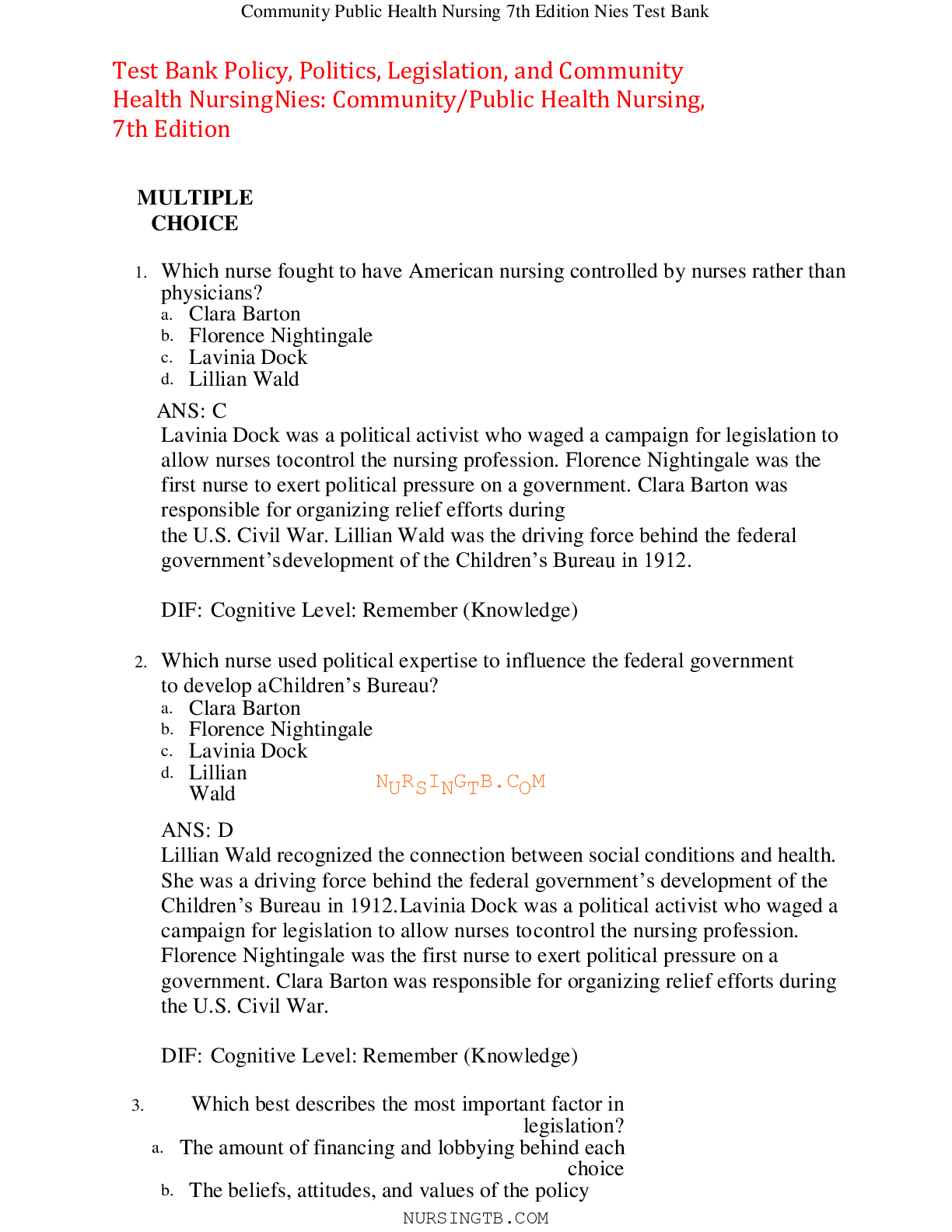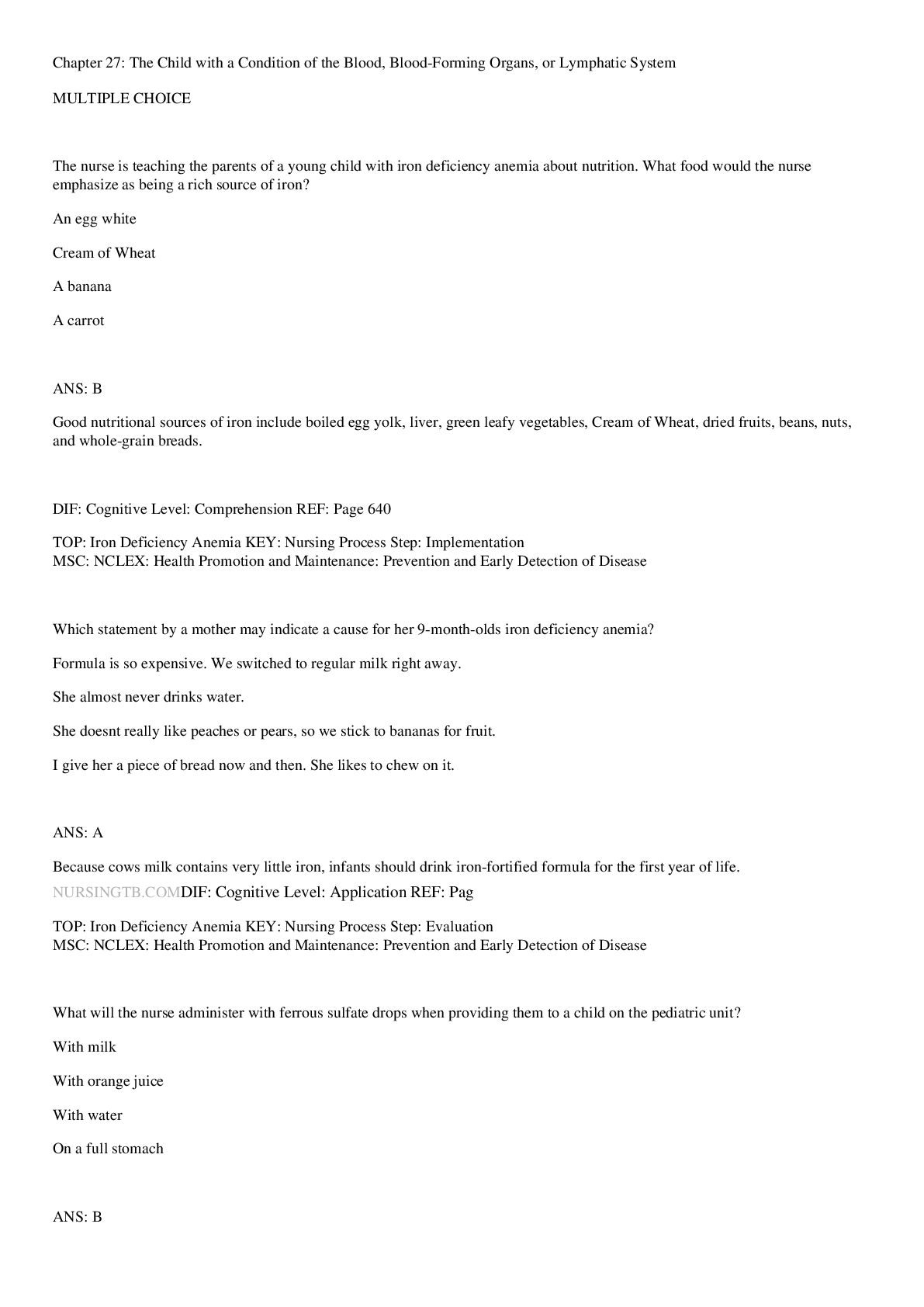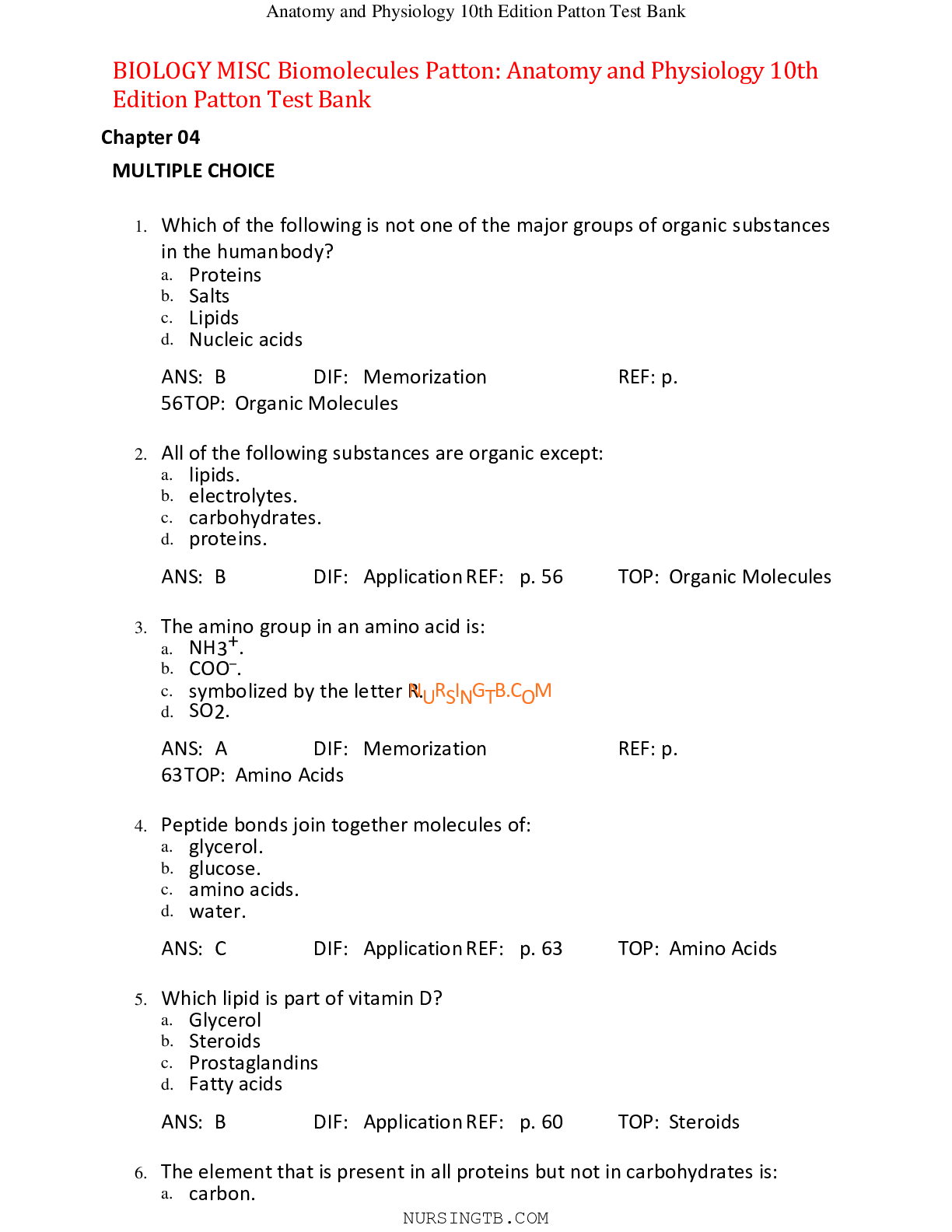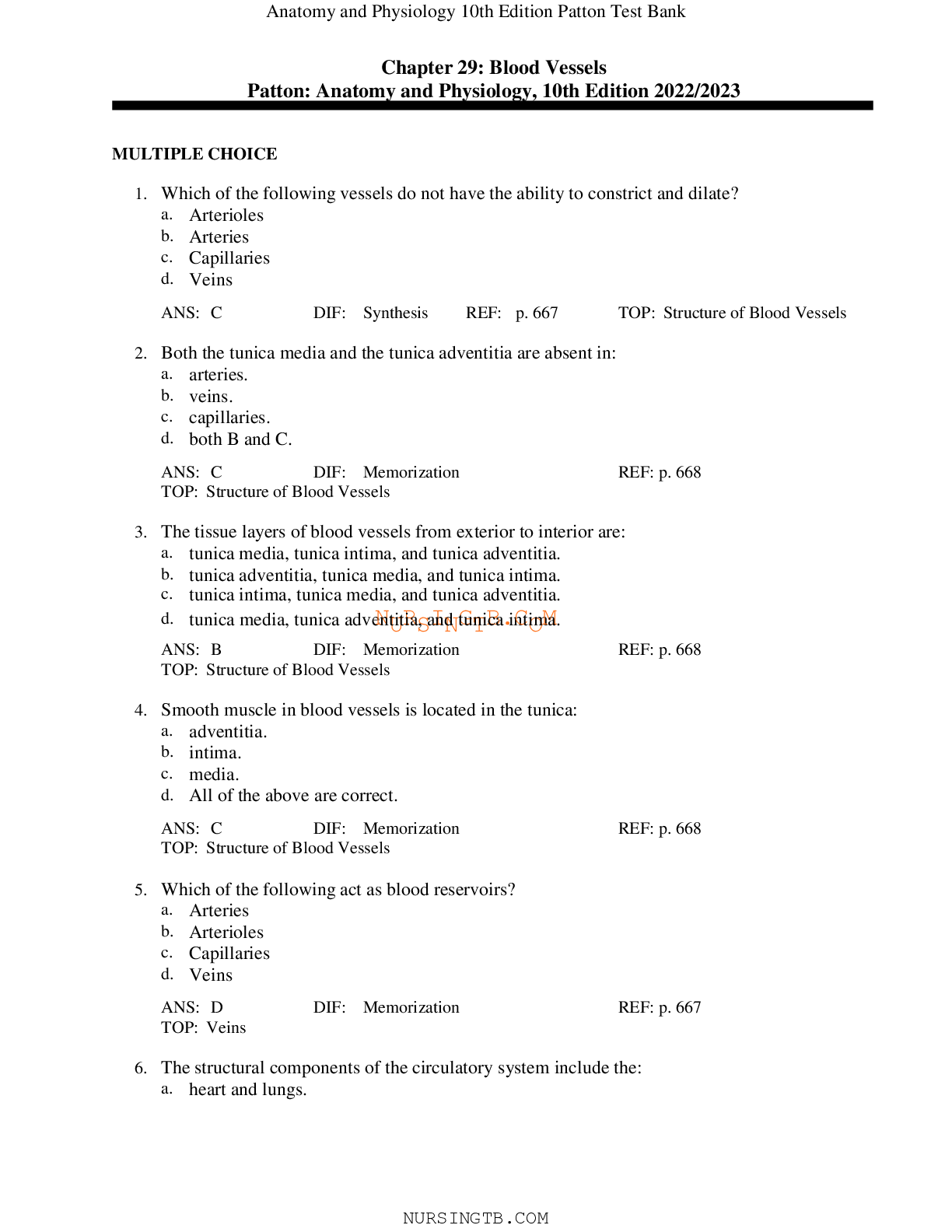*NURSING > TEST BANK > NURSE-UN 70 Homeostasis Test Bank Patton: Anatomy and Physiology, 9th Edition,100% CORRECT (All)
NURSE-UN 70 Homeostasis Test Bank Patton: Anatomy and Physiology, 9th Edition,100% CORRECT
Document Content and Description Below
NURSE-UN 70 Homeostasis Test Bank Patton: Anatomy and Physiology, 9th Edition Chapter 02: Homeostasis Test Bank MULTIPLE CHOICE 1. Of the 11 major body systems, which is the least involved in mai... ntaining homeostasis? a. Circulatory b. Endocrine c. Lymphatic d. Reproductive ANS: D DIF: Application REF: TOP: System Level 2. Homeostasis can best be described as: a. a constant state maintained by living and nonliving organisms. b. a state of relative constancy. c. adaptation to the external environment. d. changes in body temperature. ANS: B DIF: Application REF: TOP: Homeostasis 3. Which of the following is not one of the basic components in a feedback control loop? a. Effector mechanism b. Transmitter c. Sensor d. Integrating center ANS: B DIF: Memorization REF: TOP: Basic Components of Control Mechanisms 4. The body’s thermostat is located in the: a. heart. b. cerebellum. c. pituitary. d. hypothalamus. ANS: D DIF: Memorization REF: TOP: Basic Components of Control Mechanisms 5. The contraction of the uterus during the birth of a baby is an example of feedback. a. negative b. positive c. inhibitory d. deviating ANS: B DIF: Memorization REF: TOP: Positive-Feedback Control Systems 6. Negative-feedback mechanisms: a. minimize changes in blood glucose levels. b. maintain homeostasis. c. are responsible for an increased rate of sweating when air temperature is higher than body temperature. d. All of the above are correct. ANS: D DIF: Memorization REF: TOP: Negative-Feedback Control Systems 7. Pathogenesis can be defined as: a. a specific disease. b. a group of diseases. c. the course of disease development. d. a subgroup of viruses. ANS: C DIF: Memorization REF: TOP: Disease Terminology 8. Intracellular parasites that consist of DNA or RNA surrounded by a protein coat and sometimes by a lipoprotein envelope are called: a. viruses. b. bacteria. c. fungi. d. protozoa. ANS: A DIF: Memorization REF: TOP: Basic Mechanisms of Disease 9. The term that literally means self-immunity is: a. autoimmunity. b. homoimmunity. c. passive immunity. d. active immunity. ANS: A DIF: Memorization REF: TOP: Basic Mechanisms of Disease 10. Epidemiology is the study of the of diseases in human populations. a. occurrence b. distribution c. transmission d. All of the above are correct. ANS: D DIF: Memorization REF: Page 25 (Box 1-4) TOP: Disease Terminology 11. Which of the following may put one at risk for developing a given disease? a. Environment b. Stress c. Lifestyle d. All of the above ANS: D DIF: Memorization REF: TOP: Mechanisms of Disease 12. Negative-feedback control systems: a. oppose a change. b. accelerate a change. c. have no effect on the deviation from set point. d. establish a new set point. ANS: A DIF: Memorization REF: TOP: Negative-Feedback Control Systems 13. Positive-feedback control systems: a. have no effect on the deviation from set point. b. accelerate a change. c. ignore a change. d. do not exist in human systems. ANS: B DIF: Memorization REF: TOP: Positive-Feedback Control Systems 14. Shivering to try to raise your body temperature back to normal would be an example of: a. the body trying to maintain homeostasis. b. a positive-feedback mechanism. c. a negative-feedback mechanism. d. both A and C. ANS: D DIF: Synthesis REF: TOP: Homeostasis/Negative-Feedback Control Systems 15. Eponyms are scientific terms that: a. sound alike but are spelled differently. b. can have more than one meaning. c. are based on a person’s name. d. are none of the above. ANS: C DIF: Memorization REF: TOP: The Language of Science and Medicine 16. Which of the following is a protein substance with no DNA or RNA and is thought to be the cause of mad cow disease? a. Virus b. Bacteria c. Prion d. Protozoan ANS: C DIF: Memorization REF: TOP: Pathogenic Organisms 17. Of the pathogenic organisms, which of the following are the most complex? a. Viruses b. Tapeworms c. Bacteria d. Protozoa ANS: B DIF: Memorization REF: TOP: Pathogenic Organisms 18. If the secretion of oxytocin during childbirth operated as a negative- feedback control loop, what effect would it have on uterine contractions? a. Oxytocin would stimulate stronger uterine contractions. b. Oxytocin would inhibit uterine contractions. c. There would be no changes in the strength of the uterine contractions. d. Uterine contractions would initially be weak and then gain strength after the release of the hormone. ANS: B DIF: Application REF: TOP: Positive-Feedback Control Systems 19. Intrinsic control: a. usually involves the endocrine or nervous system. b. operates at the cellular level. c. is sometimes called autoregulation. d. operates at the system or organism level. ANS: C DIF: Memorization REF: TOP: Levels of Control MATCHING Match each term with its corresponding definition or explanation a. Prion b. Tumor c. Fungi d. Gene mutation e. Bacteria f. Virus g. Protozoa 1. An intracellular parasite that consists of an RNA or DNA core surrounded by a protein coat 2. A type of protein that converts normal protein in the nervous system into abnormal proteins that cause loss of function 3. A tiny, primitive cell that lacks a nucleus and can cause infection 4. An abnormal growth or neoplasm 5. Altered DNA that causes abnormal proteins to be made that do not perform their intended function 6. A one-celled organism whose DNA is organized into a nucleus that can parasitize human tissue 7. Simple organisms that are similar to plants but lack chlorophyll, which allows plants to make their own food; because these organisms cannot make their own food, they parasitize human tissue 1. ANS: F DIF: Memorization REF: TOP: Basic Mechanisms of Disease 2. ANS: A DIF: Memorization REF: TOP: Basic Mechanisms of Disease 3. ANS: E DIF: Memorization REF: TOP: Basic Mechanisms of Disease 4. ANS: B DIF: Memorization REF: TOP: Basic Mechanisms of Disease 5. ANS: D DIF: Memorization REF: TOP: Basic Mechanisms of Disease 6. ANS: G DIF: Memorization REF: TOP: Basic Mechanisms of Disease 7. ANS: C DIF: Memorization REF: TOP: Basic Mechanisms of Disease SHORT ANSWER 1. Diagram a homeostatic control mechanism, including the three basic components. ANS: Answers will vary. DIF: Synthesis REF: TOP: Homeostatic Control Mechanisms 2. How does childbirth demonstrate positive feedback? ANS: Answers will vary. DIF: Synthesis REF: TOP: Positive-Feedback Control Systems 3. Give an example of how categories of risk factors or predisposing conditions could overlap. ANS: Answers will vary. DIF: Synthesis REF: TOP: Basic Mechanisms of Disease 4. Explain the feed-forward control system, and give an example of one in the body. ANS: Answers will vary. DIF: Application REF: TOP: Feed-Forward in Control Systems ESSAY 1. Give an example of a system, either living or nonliving, that is designed to maintain a relatively constant condition by using a negative-feedback mechanism. Explain briefly how the system works to accomplish this. ANS: Answers will vary. DIF: Synthesis REF: TOP: Basic Components of Control Mechanisms [Show More]
Last updated: 1 year ago
Preview 1 out of 17 pages

Buy this document to get the full access instantly
Instant Download Access after purchase
Add to cartInstant download
We Accept:

Reviews( 0 )
$15.00
Document information
Connected school, study & course
About the document
Uploaded On
Dec 19, 2022
Number of pages
17
Written in
Additional information
This document has been written for:
Uploaded
Dec 19, 2022
Downloads
0
Views
55


















